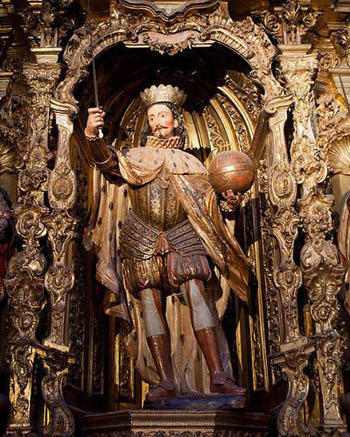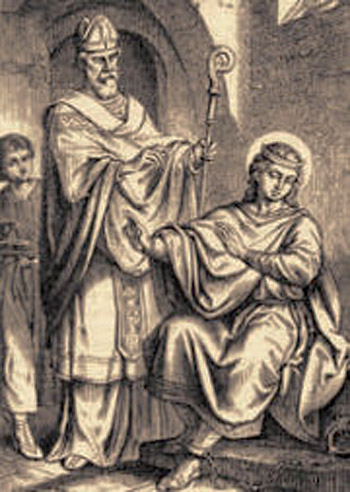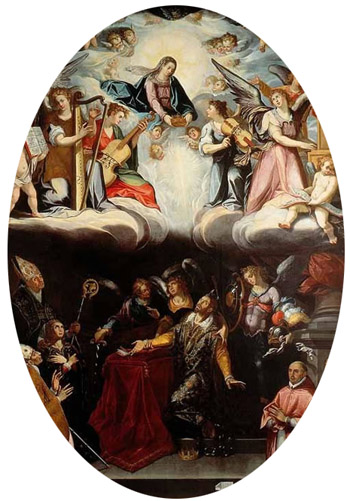The Saint of the Day
 |
 |
 |
 |
 |
 |
 |
St. Hermenegild - April 13
Comments of Prof. Plinio:
Arianism dominated Spain around the year 550. The Visigoth King was Leovigild who professed this heresy with his sons Hermenegild and Reccared. They were great defenders of that sect. When his two sons were of age, Leovigild named Hermenegild to the throne of Seville to govern on his behalf and Reccared to the throne of Toledo.
In 579 Hermenegild married Ingund, Princess of Austrasia, the daughter of King Sigebert I, a fervent Catholic.
 His young wife was pressured by Hermenegild's stepmother Goiswintha to abjure her Catholic Faith and enter the Arian heresy. But this Princess not only remained faithful to the True Faith, but managed to convert her husband, who had been such a strong defender of Arianism. Hermenegild with great pomp abjured his error and was admitted into the Catholic Church by
St. Leander, Bishop of Seville, the younger brother of St. Isidore.
His young wife was pressured by Hermenegild's stepmother Goiswintha to abjure her Catholic Faith and enter the Arian heresy. But this Princess not only remained faithful to the True Faith, but managed to convert her husband, who had been such a strong defender of Arianism. Hermenegild with great pomp abjured his error and was admitted into the Catholic Church by
St. Leander, Bishop of Seville, the younger brother of St. Isidore.
King Leovigild became so angry that he threatened to dethrone Hermenegild should he not return to Arianism. The son respectfully replied to his father that, given the choice of losing the crown or giving up the True Faith after having found it, he would rather disobey his father than God, and that he could take back the crown if he so desired.
Leovigild assembled a large army and laid siege to Seville for almost two years. Hermenegild was obliged to flee to Cordoba and then to the well-fortified city of Osseto. When he realized that resistance was futile, he went to a much venerated church in that city to take refuge there.
A younger brother of Hermenegild, still a boy, came to him and begged him to make peace with their father and promised his pardon. The King of Seville accepted the proposal and left the sanctuary of the church to stand before his father. When he arrived before the King, Hermenegild knelt at his father's feet and asked his blessing.
At first Leovigild appeared to be moved seeing the King, his son, at his feet. But his mood quickly changed. He commanded his officials to strip his son of every royal symbol and to enchain him in a dungeon in Seville.
 Hermenegild received this treatment without flinching and with firm trust in God. To every proposal that he apostatize, he responded that he would rather lose everything than his Catholic Faith. "It is not hard for me to renounce an earthly crown, since I await an eternal one": With these words he dismissed an Arian bishop who came to the prison to bring him a sacrilegious Paschal Communion by an order of the King.
Hermenegild received this treatment without flinching and with firm trust in God. To every proposal that he apostatize, he responded that he would rather lose everything than his Catholic Faith. "It is not hard for me to renounce an earthly crown, since I await an eternal one": With these words he dismissed an Arian bishop who came to the prison to bring him a sacrilegious Paschal Communion by an order of the King.
When Leovigild heard how his son had received the prelate, he became so enraged that he decreed the death of his own son.
This sentence was communicated to the prisoner by his executioners. To their surprise, Hermenegild knelt and gave thanks to God. In that position one of the lictors beheaded him with a blow of the sword on April 13 in the year 586.
Once the crime was committed, the old King fell into deep remorse and repented of his behavior. In his last illness he called St. Leander of Seville and asked him for forgiveness and to bring his other son, King Reccared, into the Catholic Faith.
The martyrdom of King Hermenegild was the first step of the conversion of all of Spain.

(From O Legionário, April 9, 1939, n.343)


The Saint of the Day features highlights from the lives of saints based on comments made by the late Prof. Plinio Corrêa de Oliveira. Following the example of St. John Bosco who used to make similar talks for the boys of his College, each evening it was Prof. Plinio’s custom to make a short commentary on the lives of the next day’s saint in a meeting for youth in order to encourage them in the practice of virtue and love for the Catholic Church. TIA thought that its readers could profit from these valuable commentaries.
The texts of both the biographical data and the comments come from personal notes taken by Atila S. Guimarães from 1964 to 1995. Given the fact that the source is a personal notebook, it is possible that at times the biographic notes transcribed here will not rigorously follow the original text read by Prof. Plinio. The commentaries have also been adapted and translated for TIA’s site.
Arianism dominated Spain around the year 550. The Visigoth King was Leovigild who professed this heresy with his sons Hermenegild and Reccared. They were great defenders of that sect. When his two sons were of age, Leovigild named Hermenegild to the throne of Seville to govern on his behalf and Reccared to the throne of Toledo.
In 579 Hermenegild married Ingund, Princess of Austrasia, the daughter of King Sigebert I, a fervent Catholic.

The martyrdom of King Hermenogild was the first step to Spain's conversion
King Leovigild became so angry that he threatened to dethrone Hermenegild should he not return to Arianism. The son respectfully replied to his father that, given the choice of losing the crown or giving up the True Faith after having found it, he would rather disobey his father than God, and that he could take back the crown if he so desired.
Leovigild assembled a large army and laid siege to Seville for almost two years. Hermenegild was obliged to flee to Cordoba and then to the well-fortified city of Osseto. When he realized that resistance was futile, he went to a much venerated church in that city to take refuge there.
A younger brother of Hermenegild, still a boy, came to him and begged him to make peace with their father and promised his pardon. The King of Seville accepted the proposal and left the sanctuary of the church to stand before his father. When he arrived before the King, Hermenegild knelt at his father's feet and asked his blessing.
At first Leovigild appeared to be moved seeing the King, his son, at his feet. But his mood quickly changed. He commanded his officials to strip his son of every royal symbol and to enchain him in a dungeon in Seville.

Hermenegild refuses the Easter Communion from the Arian bishop
When Leovigild heard how his son had received the prelate, he became so enraged that he decreed the death of his own son.
This sentence was communicated to the prisoner by his executioners. To their surprise, Hermenegild knelt and gave thanks to God. In that position one of the lictors beheaded him with a blow of the sword on April 13 in the year 586.
Once the crime was committed, the old King fell into deep remorse and repented of his behavior. In his last illness he called St. Leander of Seville and asked him for forgiveness and to bring his other son, King Reccared, into the Catholic Faith.
The martyrdom of King Hermenegild was the first step of the conversion of all of Spain.

The martyrdom of King Hermenegild,
by Alonso Vazquez
(From O Legionário, April 9, 1939, n.343)

 | |
|
|
The texts of both the biographical data and the comments come from personal notes taken by Atila S. Guimarães from 1964 to 1995. Given the fact that the source is a personal notebook, it is possible that at times the biographic notes transcribed here will not rigorously follow the original text read by Prof. Plinio. The commentaries have also been adapted and translated for TIA’s site.


